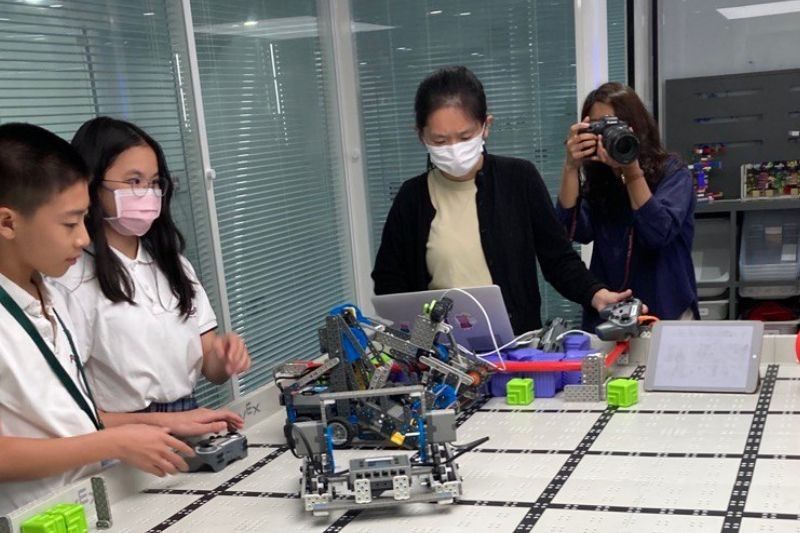In Hong Kong, schools compete to create the next best learning innovation

HONG KONG, People’s Republic of China — As the world of education deals with the changes brought by artificial intelligence (AI), the Hong Kong education sector will soon be getting ready for something else: a first-of-its-kind artificial intelligence tool enabling students to "chat" with wartime heroes.
Before this, another first-of-its-kind robotics program was pilot-launched for primary school students in 26 schools, which came with “editable” teaching resources and teacher training workshops to ensure that the lessons on robotics were tailor-fit to students.
Hong Kong’s education officials have long been on a campaign to achieve a “culture of innovation” among its schools, teachers and students, Katharine Choi of the Hong Kong Education Bureau said.
Among the mechanisms it relies on to achieve this is the Quality Education Fund (QEF) which incentivizes schools to compete with each other every year to pitch the most innovative teaching and learning projects.
“QEF has been established for 25 years. It’s a very popular funding for schools and we do a lot of promotion of QEF projects. It's very common for schools — if they have some new ideas that they want to try — they will think of applying for QEF,” Choi told Philstar.com.
QEF has supported thousands of projects in the past 25 years “with a lot of successes” that have led to students’ improved learning, Choi added.
As stated in its name, the Quality Education Fund (QEF) is a fund used by the Hong Kong government to finance projects for the promotion of quality education and to push for reform in specific education areas, including innovative projects to improve learning.
Established in 1998, the QEF was created as one of the major recommendations of the Education Commission, the advisory body set up by the government on the overall development of education in Hong Kong.
The Philippines does not have a counterpart fund similar to that of the QEF, but a similar congressional body focused on education — the Second Congressional Commission on Education (EDCOM 2) — is set to make its recommendations for education reform in 2025.
AI used to teach students about war veterans
Last year, one of the pitches approved by the QEF committee – which set a priority theme of “IT in education” — was an interactive technology project that uses artificial intelligence to allow students to have “dialogues” with key figures in China’s historical “anti-Japanese war.”
Pitched by the Academy of Chinese Studies Limited, the “AI Dialogue with Anti-Japanese Warriors" project uses images of veterans combined with audio narrating their experiences to allow students to have a “face-to-face” conversation with representations of historical figures on websites and computers.
This initiative aims to give students more opportunities to “touch" the history of the Anti-Japanese War period, and increase the "interest" in studying this history,” according to the project’s website.
“History learning should not be limited to textbooks, but should broaden the space for learning to obtain applicable resources and deepen understanding,” a description of the project’s objectives read.
About $6 million was given toward the creation of this historical learning project, which is scheduled to be completed by December 31, according to the QEF’s website.
Robotics program for primary school students
One of the “signature” QEF products that was introduced was a robotics program that benefited a total of 26 schools, including 12,000 students and 100 teachers.
Implemented by the Buddhist Ho Nam Kan College, the “Robot in STEAM Education cum STEAM Education Resource Hub” implemented a three-year robotics program for grades 4 to 6 students in Hong Kong.
The program “provided hands-on experience to students” in robotics lessons by going beyond lesson plans and providing demonstration videos, 3D animations and a “production guide of different types of robots,” according to the Hong Kong education bureau.
Teachers were also given “editable” resource packages to tailor fit the lessons to their students and to their respective paces in learning.
Along with the learning resources, teachers also underwent training programs to be able to deliver the lessons comprehensively.
Hong Kong has significantly fewer students than the Philippines at both the basic and higher education level. Hong Kong only has about 650,000 students in basic education compared to the Philippines’ 27 million, according to the Philippines’ Department of Education’s latest enrollment data.
The governments of both the Hong Kong and the Philippines spend about the same portion of their overall budget on education, with Hong Kong using 3.6% of its total budget and the Philippines using 3.7%.
Choi said that the QEF was instrumental in developing a culture of “always coming up with new ideas to improve education” among the people who need it the most — teachers and students.
“The projects that get approved serve as examples of what others can achieve. Whether you’re from a government or private school, you’re encouraged to pitch your own ideas and be creative,” Choi added.
Disclosure: Reporting for this story was made possible with support from the Hong Kong Government's Information Services Department (ISD). This article was produced following editorial guidelines and ISD did not have input on how the story would be written.
- Latest
- Trending

































